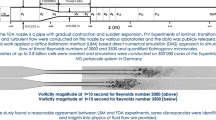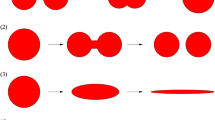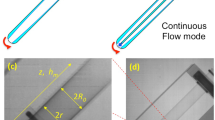Abstract
The mixing of stratified miscible fluids with widely different material properties is a common step in biopharmaceutical manufacturing processes. Differences between the fluid densities and viscosities, however, can lead to order-of-magnitude increase in blend times relative to the blending of single-fluid systems. Moreover, the mixing performance in two-fluid systems can be strongly dependent on the Richardson number defined as the ratio of fluid buoyancy to fluid inertia. In this work, we combine lattice Boltzmann transport algorithms with graphics card-based computing hardware to build accelerated digital twins of a physical mixing tanks. The digital twins are designed to predict real-time fluid mechanics with a fidelity that rivals experimental characterization at orders-of-magnitude less cost than physical testing. After validating the twins against measured single- and multi-fluid mixing data, we use them to explore the physics governing fluid blending in stratified two-fluid systems. We use output from the twins to provide general guidance on stratified two-fluid mixing processes, as well as guidance for building such models for other types of physical systems.















Similar content being viewed by others
References
(2019) Retrieved August 6, 2020, from M-Star CFD: http://mstarcfd.com
(2020)Retrieved August 6, 2020, from Amazon EC2 P3 Instances: https://aws.amazon.com/ec2/instance-types/p3/
Benchabane A, Bekkour K. Rheological properties of carboxymethyl cellulose (CMC) solutions. Colloid Polym Sci. 2008;286(10):1173–80.
Derksen JJ. Blending of miscible liquids with different densities starting from a stratified state. Comput Fluids. 2011;50(1):35–45.
Doran, P. M. (2013). Mixing. In Bioprocess Engineering Principles (2nd ed., pp. 255-332). London: Academic Press.
Gerhardt A, M. N. Protein aggregation and particle formation in prefilled glass syringes 2014; 103(6), 1601-1612.
Gikanga B, Chen Y, Stauch OB, Maa YF. Mixing monoclonal antibody formulations using bottom-mounted mixers: impact of mechanism and design on drug product quality. PDA J Pharm Sci Technol. 2015;69(2):284–96.
Guo, Z., & Shu, C. (2013). Lattice Boltzmann method and its applications in engineering (Vol. 3). World Scientific.
HE Vd. Lattice Boltzmann simulations for multi-scale chemical engineering 2018; 21(67-75).
Jameel, F., Czyzewski, A. M., Zhu, T., Sinha, K., & Nere, N. K. (2020). Development and scale-up of the mixing process for biopharmaceuticals. In Development of Biopharmaceutical Drug-Device Products (pp. 539-565). Springer.
Jun AH. Coefficient of variation. In Encyclopedia of Research Design 2010; (pp. 169-171).
Krüger T, Kusumaatmaja H, Kuzmin A, Shardt O, Silva G, Viggen EM. The lattice Boltzmann method. Springer International Publishing. 2017;10(978-3):4–15.
Ma Z. Impeller power draw across the full Reynolds number spectrum. MS Thesis: University of Dayton; 2014.
Mahler HC, M. R.. Induction and analysis of aggregates in a liquid IgG1-antibody formulation. 2005; 59((3)), 407-17.
Mohamad AA. Lattice Boltzmann method: fundamentals and engineering applications with computer codes. 2nd ed. London: Springer; 2019.
Nere NK, Patwardhan AW, Joshi JB. Liquid-phase mixing in stirred vessels: turbulent flow regime. Ind Eng Chem Res. 2003;42(12):2661–98.
Paul EL, Atiemo-Obeng VA, Kresta SM. Handbook of industrial mixing: science and practice: John Wiley & Sons; 2004.
Söderberg R, Wärmefjord K, Carlson JS, Lindkvist L. Toward a digital twin for real-time geometry assurance in individualized production. CIRP Ann. 2017;66(1):137–40.
Strand A. Investigation of blend time for turbulent Newtonian fluids in stirred tanks. Rochester Institute of Technology: MS Thesis; 2017.
Succi S. The lattice Boltzmann equation: for fluid dynamics and beyond: Oxford University Press; 2001.
Sukop M, Thorne DT. Lattice Boltzmann modeling: Springer; 2006.
van Driest ER. On Turbulent Flow Near a Wall. 1956;23:1007–11.
Van Leer B. Towards the ultimate conservative difference scheme III. Upstream-centered finite-difference schemes for ideal compressible flow. J Comput Phys. 1977;23(3):263–75.
Verzicco R, F. M. (2004). Flow in an impeller-stirred tank using an immersed-boundary method. 50(6). Retrieved from www.mstarcfd.com
Yang SS. GPU-accelerated large eddy simulation of stirred tanks. 2018; 181, 132-145.
Yu H, Girimaji SS, Luo L-S. Lattice Boltzmann simulations of decaying homogeneous isotropic turbulence. Phys Rev E. 2005;71(1):016708.
Yu Z, Finch BA, Hale DA. Mixing of stratified miscible liquids in an unbaffled tank with application in high concentration protein drug product manufacturing. Ind Eng Chem Res. 2018;57(9):3397–409.
Author information
Authors and Affiliations
Corresponding author
Additional information
Guest Editors: Alexander Russell and Maxx Capece
Publisher’s Note
Springer Nature remains neutral with regard to jurisdictional claims in published maps and institutional affiliations.
Rights and permissions
About this article
Cite this article
Thomas, J., Sinha, K., Shivkumar, G. et al. A CFD Digital Twin to Understand Miscible Fluid Blending. AAPS PharmSciTech 22, 91 (2021). https://doi.org/10.1208/s12249-021-01972-5
Received:
Accepted:
Published:
DOI: https://doi.org/10.1208/s12249-021-01972-5




